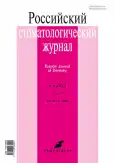Statistical evaluation of the frequency of therapeutic and diagnostic devices used by prosthetic dentists for pathology of the temporomandibular joint
- Authors: Privalova A.V.1, Leshcheva E.A.1
-
Affiliations:
- N.N. Burdenko Voronezh State Medical University
- Issue: Vol 27, No 6 (2023)
- Pages: 499-509
- Section: Clinical Investigation
- URL: https://journals.rcsi.science/1728-2802/article/view/254402
- DOI: https://doi.org/10.17816/dent492277
- ID: 254402
Cite item
Abstract
BACKGROUND: Occlusal splints are commonly used for treating myofascial and temporomandibular joint (TMJ) disorders. The success of their application depends on the knowledge of prosthetic dentists regarding TMJ disorders, device type used, splint manufacture method, treatment duration, and other factors.
AIM: This study aimed to explore various approaches of prosthetic dentists to the diagnosis of myofascial disorders, bruxism, and TMG disorders and evaluate the methods of therapy used in clinical practice.
MATERIALS AND METHODS: A survey and questionnaire was conducted among orthopedic dentists in the city of Voronezh working in private or state dental organizations, on the topic “Pathology of the temporomandibular joint and methods of therapy”. The question list consisting of 15 questions was developed for statistical evaluation of therapeutic and diagnostic constructions used by prosthetic dentists in their clinical practice in cases related to the pathology of the TMJ. During this study, specially designed questionnaires were filled out. Furthermore, the conversation with each participant was conducted for a direct analysis of orthopedic measures of TMJ disorders.
To analyze the obtained values, the criterion χ2 or Pearson’s criterion of agreement, Fisher’s exact criterion, and Kramer’s V criterion were used. The confidence interval was set to 95%.
RESULTS: Among the surveyed doctors, 78 (65.0%) had more than 15 years of experience, 27 (22.5%) had 5–15 years of experience, and 15 (12.5%) had less than 5 years of experience. When using a single-sample binomial criterion, the number of doctors working in different institutions significantly differed (p <0.001). Thus, majority of the surveyed doctors (n=102; 85%) worked in state-funded clinics and the remaining (n=18; 15%) in private clinics (p <0.001). Moreover, 25 respondents (20.8%) claimed that they do not use tires in their practice, whereas the remaining 95 (79.2%) do.
CONCLUSIONS: The participation of prosthetic dentists in this study demonstrated their high interest in “Pathology of the temporomandibular joint and methods of therapy”. The results of the survey indicate a change in the level of dentists’ knowledge with increasing professional experience. The methods of therapy used by the study participants considerably differ and often do not comply with the basic recommendations of the Dental Association of Russia.
Full Text
##article.viewOnOriginalSite##About the authors
Anna V. Privalova
N.N. Burdenko Voronezh State Medical University
Author for correspondence.
Email: anna.priwalowa13@gmail.com
ORCID iD: 0009-0008-1646-0788
SPIN-code: 9462-7179
Russian Federation, Voronezh
Elena A. Leshcheva
N.N. Burdenko Voronezh State Medical University
Email: el.leshewa@yandex.ru
ORCID iD: 0000-0001-6290-6551
SPIN-code: 1068-1617
MD, Dr. Sci (Medicine), Professor
Russian Federation, VoronezhReferences
- Dawson PE. Functional occlusion from the temporomandibular joint to smile planning: trans. from English. Konev DB, editor. Moscow: Practical Medicine; 2016. 592 p.
- Lebedenko IYu, Arutyunov SD, Ryakhovskiy AN, editors. Ortopedicheskaya stomatologiya: natsional’noe rukovodstvo. Moscow: GEOTAR-Media; 2019. (In Russ).
- Minervini G, Nucci L, Lanza A, et al. Temporomandibular disc displacement with reduction treated with anterior repositioning splint: a 2-year clinical and magnetic resonance imaging (MRI) follow-up. Journal of Biological Regulators and Homeostatic Agents. 2020;34(1 Suppl. 1):151–160.
- Fadeev RA, Ovsyannikov KA, Zhidkikh ED. Application of occlusal splints and diagnostic appliances in management of diseases of temporomandibular joint and masticatory muscles. The Dental Institute. 2020;(3):78–81. EDN: YFMLEF
- Naumovich SS, Korhova NV, Fedosenko AL. Bruxism: actual principles of diagnosis and treatment planning with Brux Checker. Mezhdunarodnye obzory: klinicheskaya praktika i zdorov’e. 2018;(4):66–74. EDN: YWNRCP
- Kaymak D, Karakis D, Dogan A. Evolutionary spectral analysis of temporomandibular joint sounds before and after anterior repositioning splint therapy in patients with internal derangement. Int J Prosthodont. 2019;32(6):475–481. doi: 10.11607/ijp.6269
- Tamazyan NG, Starikova IV, Radyshevskaya TN, Bobrov DS. Comparative characteristics of methods of deprogramming of the masticatory muscles. Colloquium-Journal. 2019;(3-2):36–38. EDN: VUQHGP
- Riley P, Glenny AM, Worthington HV, et al. Oral splints for patients with temporomandibular disorders or bruxism: a systematic review and economic evaluation. Health Technol Assess. 2020;24(7):1–224. doi: 10.3310/hta24070
- Vrbanović E, Alajbeg IZ. Long-term effectiveness of occlusal splint therapy compared to placebo in patients with chronic temporomandibular disorders. Acta Stomatol Croat. 2019;53(3):195–206. doi: 10.15644/asc53/3/1
- Tikhonov VE, Guskov AV, Oleinikov AA, et al. Splint therapy as a separate approach within the complex treatment of temporomandibular joint dysfunction from the point of view of physiological concepts. Science of the Young (Eruditio Juvenium). 2021;9(3):447–456. EDN: UKOFFP doi: 10.23888/HMJ202193447-456
Supplementary files






